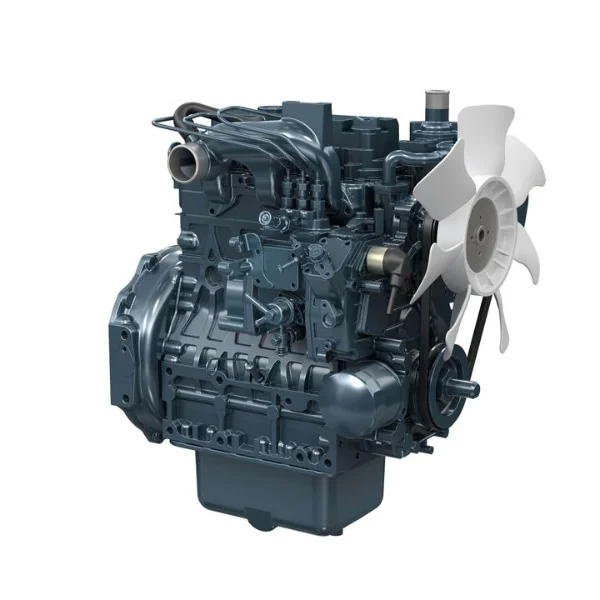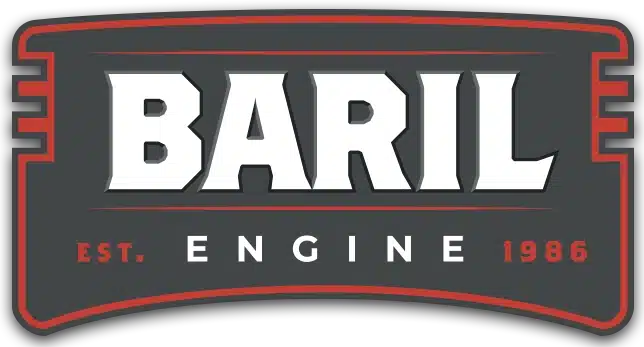
In 2021 Kubota celebrated its three millionth engine sold in the United States. These are very popular engines! Baril Engine has worked on over 400 Kubota engines in the past two years alone. One of the Kubota models that we see regularly is their 03 Series.
These engines have a wide range of variations and are often uniquely designed around a specific piece of equipment. Frequently we have seen where a replacement engine has been purchased only to find that it will not work in a particular machine.
One overlooked service that we provide when we source Kubota parts or engines is verifying that an engine or engine component will work as a replacement in our customers’ equipment. Knowing your Kubota engine’s model number and how to use it when ordering parts or a replacement engine is very important. Check out our Kubota Engine’s Model Numbers decoder article to learn more!
Baril Engine’s Complete Engine Packages
Significant differences exist in what one engine rebuilder includes in a “Short Block” or “Long Block” from another engine builder. If you’re comparing quotes for your Kubota 03 Series, please look at the details, as Baril Engine includes more in our packages than many other engine builders.
Baril Engine offers three levels of engine rebuild packages:
- Short Block (SB): Includes rebuilding the engine’s rotating assembly (block, crankshaft, connecting rods) and new pistons, piston ring sets, piston pins & retainers, rod pin bushings, cam bushings, lower gasket set, main bearing set, rod bearing set, and thrust washer set.
- Long Block (LB): Includes all the work in the SB level and adds a complete rebuild of the cylinder head, installation of the cylinder head, camshaft, lifters, rocker arms, upper gasket set, oil cooler, oil pump, water pump, and thermostat and adjusting of the valves.
- Ready-to-Run (RTR): Includes all the work in the SB and LB levels and adds many or all of the components and parts required for the engine to be ready to run, including the fuel injectors, fuel pump, and turbo.
Baril Engine is a custom engine builder, so our engine packages are customized to reflect each customer’s specific needs. Therefore, there can be considerable variation in the processes performed, the parts included, and the package cost from one engine project to the next. It is essential that we discuss and document within your estimate your engine’s history, any known issues, previous repairs, and your specific needs and goals. The more information you provide us, the better positioned we are to meet your needs and exceed your goals. Please always refer to your written estimate to know what is and is not included in your engine package.
Baril Engine’s Machining, Rebuilding, and Assembly Services
Disassembly and Cleaning
A thorough and quality job of cleaning the engine components is a time-consuming and labor-intensive job. However, we firmly believe that it is the foundation of our entire process.
Disassembly and Cleaning details
- Disassembly of the engine and all its components.
- Initial cleaning of the components with a high temp spray wash process.
- Remove any remaining carbon or material from the parts using a variety of hand and pneumatic cleaning tools and processes.
Return to top of Machining, Rebuilding, and Assembly Services Section
Cylinder Head
[Available individually or as part of the LB & RTR packages.]
Cylinder Head Inspection details
- Magnaflux the cylinder head to identify any previously undetected cracks. Magnaflux Testing, also known as magnetic particle inspection, uses a magnetic field and an iron oxide powder or solution to identify surface cracks in metals. It is a time-proven and reliable method of identifying external cracks.
- Pressure testing the cylinder head, as the name suggests, uses air or hot water pressure to test the integrity of the internal coolant passages of the part. With this test, we can find cracks in the head’s coolant passages, leaking frost plugs, and other defects that need to be addressed as a part of our rebuild process.
- Inspect the valves for stem wear, straightness, and if they have sufficient margin to allow grinding.
- Inspect the valve guides for wear and proper clearance.
- Inspect valve seats for wear and defects.
Cylinder Head Rebuilding Process details
- Resurface (mill) the cylinder head’s deck to ensure it is straight, flat, and has the proper finish.
- Grind the valves or replace as needed.
- Install new valve seats as needed and cut to produce three-angle valve seats.
- Remove & replace valve guides as needed.
- Replace valve springs with new.
- Assemble the cylinder head and complete the final inspection of the finished head to verify it meets all specifications.
Return to top of Machining, Rebuilding, and Assembly Services Section
Engine Block
[Available individually or as part of a complete engine rebuild package.]
Engine Block Inspection details
- Magnaflux the block to identify any previously undetected cracks.
- Inspect and measure each main journal bore with a dial bore gauge after torquing the main caps on to specification. This inspection allows us to see if any of the main journal bores need to be resized.
Engine Block Reconditioning Process details
- Resurface (mill) the block’s top deck to ensure it is straight, flat, and has the proper finish.
- We bore and hone the block as needed to achieve the proper size and crosshatch bore finish.
Return to top of Machining, Rebuilding, and Assembly Services Section
Connecting Rods
[Available individually or as part of a complete engine rebuild package.]
Connecting Rod Inspection details
- Liquid Magnaflux each of the connecting rods to identify any previously undetected cracks. Any rod found to have a crack or defect is replaced.
Connecting Rod Reconditioning Process details
- Connecting rod piston pin housing bore (small end): The piston pin bushing on the small end of the connecting rod is subject to wear over time. We recondition the piston pin end on each connecting rod by removing and replacing the pin bushing and honing it to fit the new piston pin to achieve the specified clearance.
- Connecting rod crankpin housing bore (big end): If during our inspection a rod’s crankpin housing bore is found to be deformed or worn, we resize the bore by cutting the cap, torquing the cap on to specification, and bore and hone the crankpin bore to specified size and finish.
Return to top of Machining, Rebuilding, and Assembly Services Section
Crankshaft and Camshaft
[Available individually or as part of a complete engine rebuild package.]
Crankshaft and Camshaft Inspection details
- Liquid Magnaflux the crankshaft to identify any previously undetected cracks. Any crankshaft found to have a crack or defect is replaced.
- Inspect and test the journals to verify they meet or exceed the required hardness specification.
- Inspect the crankshaft for straightness and measure the size and profile of each journal to verify they are as specified.
- Inspect the camshaft and determine if it can be reused or needs to be replaced.
Crankshaft Reconditioning Process details
- If required, we grind the crankshaft after we have verified that oversized bearings are available.
- Polish all the crankshaft’s rod and main journals to their required finish.
Return to top of Machining, Rebuilding, and Assembly Services Section
Engine Assembly
[Available as part of a complete engine rebuild package.]
Pre-Assembly Engine Inspection details
- It is the assembling technician’s responsibility to inspect all parts and verify that each meets specification. We trust but verify!
Engine Assembly details
- Our highly experienced engine builders assemble all our engines in our assembly department, which is sealed off from the remainder of our shop.
- Our engine assembly is a process that involves many detailed procedures that are executed in a specific order by our engine builders so that the completed engine meets our performance and reliability standards.
Return to top of Machining, Rebuilding, and Assembly Services Section
The Versatility of the Kubota 03 Series
Kubota’s 03 & 03-M Series includes vertical diesel engines ranging from 24.8-74.3 horsepower / 2200-2700 RPM. The 03 Series powers medium-power applications such as:
- Aerial Work Platforms
- Air Compressors
- Compactors
- Forklifts
- Generators
- Mowers
- Pressure Washers
- Pumps
- Refrigeration
- Skid Steers
- Sweepers
- Welders
- Wood Chippers
The Kubota 03 Series and 03-M Series are available in indirect, direct, and Common-Rail Direct Injection systems. Naturally-aspirated and turbocharged versions are also available. Kubota manufactures 03 Series and 03-M Series in inline 3, 4, and 5-cylinder configurations.
Kubota 03 & 03-M Series Engine Models (click to expand)
- D1403
- D1503-M; D1503-M-DI; D1503-M-DI-T
- D1703-M; D1703-M-DI
- D1803-M; D1803-M-DI; D1803-CR; D1803-CR-T; D1803-CR-TI
- V1903
- V2003; V2003-T; V2003-M-T
- V2203; V2203-DI
- V2403-M; V2403-M-T; V2403-CR-T; V2403-CR-TI
- F2503-DI; F2503-T; F2803; F2803-DI
Kubota Engines power more than just Kubota equipment – other original manufacturers utilizing Kubota’s 03 & 03-M Series include ASV, Bobcat, Caterpillar, Jacobson, Takeuchi, and Toro.

